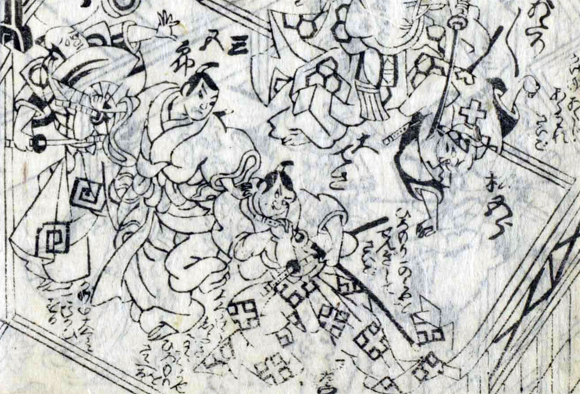| KUSEMAI |
| Play title | Kiichi H˘gen Sanryaku no Maki |
| Common title | Kusemai The Old Dance |
| Authors | Hasegawa Senshi Matsuda Bunk˘d˘ |
| History |
The play "Kiichi H˘gen Sanryaku no Maki" was originally written for the puppet theater (Bunraku) and staged for the first time in the 9th lunar month of 1731 in ďsaka at the Takemotoza. It was adapted for Kabuki at the end of the same year and produced for the first time in the 12th lunar month of 1731 at the Kado no Shibai. The zamoto was Arashi Kokuseki (unknown casting). It was produced by Arashi Koroku I in the first quarter of 1732 in Ky˘to with the actors Mihogi Gizaemon I and Ichiyama Sukegor˘ I playing the roles of Yoshioka Kiichi H˘gen and Ichij˘ ďkura Naganari. Arashi Kokuseki produced the play one more time in ďsaka at the Kado no Shibai in the 3rd and 4th lunar months of 1732 [casting]. It was performed for the first time in Edo, at the Moritaza, in the 1st lunar month of 1757 [casting]. |
| Structure |
The play "Kiichi H˘gen Sanryaku no Maki" is in 5 acts. "Kusemai", 'the Old Dance' in English, is the 2nd scene of 4th act. It is occasionally staged with the very popular "Ichij˘ ďkura Monogatari" scene. |
| Key words |
Genpei Kassen Genpei-kassenmono Genji Gidayű Ky˘gen Heike Jidaimono Kusemai Minamoto Yoshitomo Taira Kiyomori Tokiwa Gozen |
| Summary |
Lord Ichij˘ ďkura Naganari's kar˘ Yatsurugi Kageyu and Harima Daij˘ Hiromori are plotting together to take advantage of Lord Ichij˘'s imbecility and eventually usurp his estate. Hiromori is suspicious of the fact that Tokiwa Gozen should have so docilely agreed to become the wife of such an idiot daimy˘, and fears that Tokiwa Gozen means to utilize her husband's imbecility and make the mansion a focal point to gather support for the Genji cause. Hiromori comes at Lord Ichij˘'s mansion to discuss this critical issue with Kageyu. He is surprised to find Kageyu in a quite unusual costume. The senior retainer explains that he has been called on to humor his lord by wearing the costume and participating in a Ky˘gen farce. When Hiromori expresses his fears, Kageyu reports that he has seen nothing suspicious in Tokiwa Gozen's attitude. The only strange thing is that she practices archery nightly with a small bow and an arrow. Kageyu came to the conclusion that this is only an occupation to avoid spending time with her weak-minded husband in the bed room. Hiromori, however, is still unconvinced. Music is heard, and Lord Ichij˘ appears on stage, accompanied by Oky˘ and Naruse. Hiromori makes his greetings and Lord Ichij˘ answers in a nonsensical manner. He invites Hiromori to stay a while to witness a Ky˘gen farce put on by the two women. Hiromori finds the invitation a nuisance and tries to beg off. However, Kageyu hints to him that he should accept the invitation and ask for a performance of the sword dance. Hiromori understands this suggestion that he should take this opportunity to kill the lord, and asks for a sword dance. The sliding doors behind are opened, revealing a group of musicians to accompany Lord Ichij˘ in the dance. During the dance, Kageyu and Hiromori try to kill Lord Ichij˘, but Lord Ichij˘, while continuing his dance and pretending that he does not notice, skillfully parries all their attempts. The dance ends before the two evil characters can find a chance to strike the lord. Lord Ichij˘ departs from the room, followed by Oky˘ and Naruse and leaving two disgruntled warriors behind him. |
 |
|
Illustration for the "Kusemai" scene from the ezukushi banzuke of the drama "Kiichi H˘gen Sanryaku no Maki", which was staged in the 2nd lunar month of 1795 at the Naka no Shibai with Mimasu Matsugor˘ I, Arashi Sangor˘ II and Asao Kuzaemon I in the roles of Yatsurugi Kageyu, Ichij˘ ďkura Naganari and Harima Daij˘ Hiromori |
|
|
| Contact | Main | Top | Updates | Actors | Plays | Playwrights | Programs | Links | FAQ | Glossary | Chronology | Illustrations | Prints | Characters | Derivatives | Theaters | Coming soon | News |